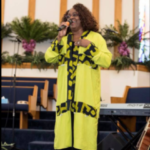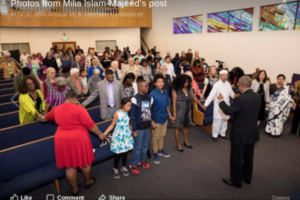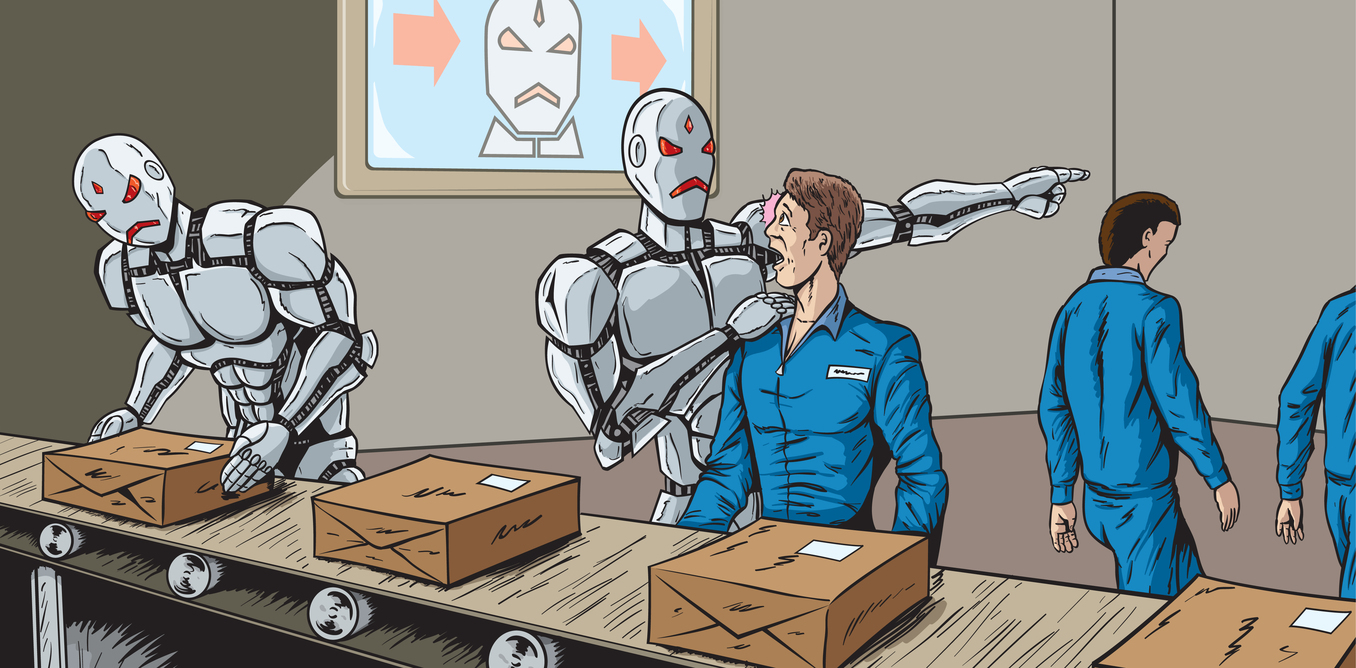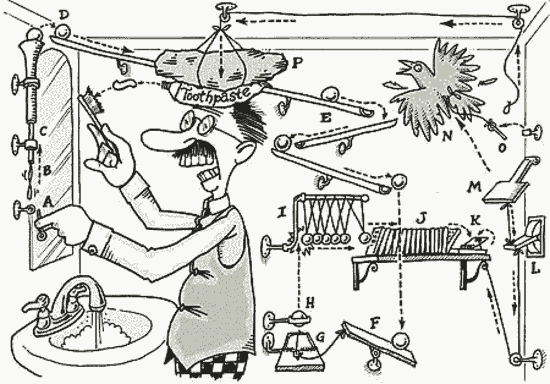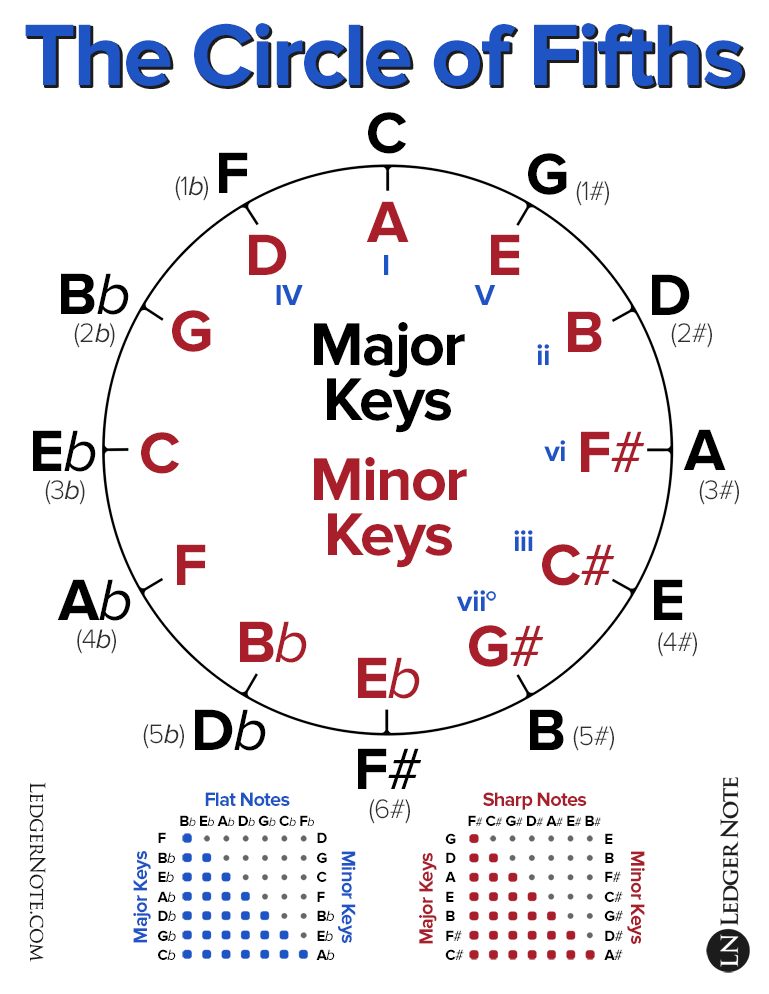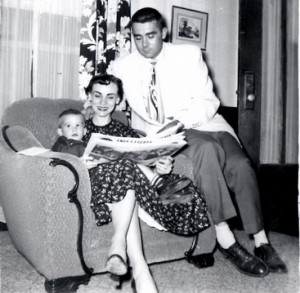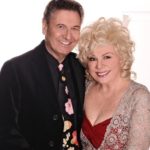We attended a stirring and enjoyable Sunday afternoon at a tribute to honor Rev. Dr. Martin Luther King Jr. by the South Coast Interfaith Council. The program was hosted by the Gospel Memorial Church of God in Christ (COGIC), Long Beach, CA.
Around 150 attended and to say the crowd was diverse would be an understatement. The program featured leaders of local Christian, Muslim, Jewish, Baha’i, Buddhist, Hindu and Zoroastrian congregations contributing to the afternoon festivities.
“We must learn to live together as brothers or perish together as fools.” Dr. Martin Luther King, Jr. from a speech in St Louis, 1964
Pastor Leon Wood Jr., served as MC. This gentleman is not only possessed of the most beautiful speaking voice I’ve heard in quite some time, but his background includes long-term activism in the homeless movement. He is retired from being Dean of the School of Business and Technology at Long Beach City College.
“Our lives begin to end the day we become silent about things that matter.” From Dr. King’s famous “I Have a Dream” speech, 1963
Among the religious leaders present, I was most surprised to find out that Zoroastrianism has not died out. I learned about this religion from an historical novel set in the 4th century BCE, and its belief system influenced both Christianity and Islam. My wife, Estelle Toby Goldstein, spoke with him at length after the service and will probably write about that in her own space (if you are not her friend, this might be the time to hook-up).
“A nation that continues year after year to spend more money on military defence than on programs of social uplift is approaching spiritual doom.” From Dr. King’s book “Where Do We Go From Here: Chaos or Community?” 1967
From my interest in music, I was already aware of the COGIC reputation for soulful, funky, grooving, gospel music and I was not disappointed. Gospel singer Erma Varnado did two numbers favored by Dr. King, “His Eyes Are On The Sparrow,” and “I Won’t Complain.” Her voice has power to rattle the windows and fixtures, and you can tell a lot of that power comes from her faith as well as her vocal muscles. She also sang two numbers at the closing of the ceremony. Her accompaniment was provided by music minister Paul Parker on the organ — and that gentleman matched the singer for fervor.
Another kind of gospel was provided by Nicholas Miller who sang and played guitar. He immediately got audience participation and moved the people to stand, clap, stomp their feet and sing along.
If you haven’t been in this type of environment before, it is happy, loud, spirited and joyful.
This isn’t the hushed worship service often associated with churches.
The keynote speaker was Michele Antoinette Dobson, a local attorney and civic activist. She’s a prominent Rotarian and specializes in defending non-profit organizations. She spoke not only of her own racial struggles, but what she has faced as a woman working to enter a traditionally male field, as a woman, and with being judged for her weight and economic background.
“Injustice anywhere is a threat to justice everywhere.” From a letter Dr. King wrote while in the Birmingham City Jail, 1963
Other speakers on the program were Maneck Bhujwala of the Zoroastrian Community of Southern California.
Milia Islam-Majeed, Executive Director of the South Coast Interfaith Council.
Spencer R. Butler, Jr. — a senior at Cal State Long Beach and a member of the student branch of NAACP.
Gretchen Krutz of the Long Beach Baha’i Community,
Naomi Rainey-Pierson, President of the Long Beach chapter of NAACP.
Sandi Zander, representing Temple Menorah of Torrance, CA.
Imam Tarek Mohamed of Long Beach Islamic Center.
Patti Heckman of the South Bay SGI Buddhist Community
Dr. Rini Ghosh of the Hindu Vedanta Society
Each of these spiritual leaders led the gathering in a call and response litany,
Ernest McBride, Sr and his children also offered reflections.
“Freedom is never voluntarily given by the oppressor; it must be demanded by the oppressed.” From a letter Dr. King wrote while in the Birmingham City Jail, 1963
The ceremony ended with everyone joining hands and singing “We Shall Overcome,” the anthem of the civil rights movement in the days of Dr. King — again accompanied by Rev Parker on organ.
The entire program was a bonding of different faiths and races, and it makes me wonder (in the words of Rodney King) — “Why can’t we all just get along,”
“Nothing in the world is more dangerous than sincere ignorance and conscientious stupidity.” From “Love In Action from Strength to Love,” 1963 by Dr. Martin Luther King, Jr.


